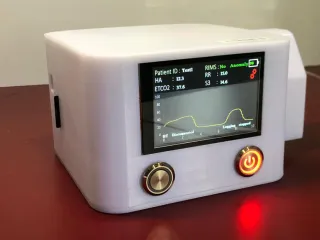Introduction: Healing process of skin or ulceration underneath a patch should not be eventful, and it must allow new tissue regeneration. SLITUP©, a resorbable, bioactive composite film patch is bacteriostatic and possess ionic elements which is enhanced following sterilization using gamma irradiation, is proposed as an innovative solution for soft tissue regeneration. SLITUP© reduce the needs for frequent plaster change, hence reducing subject expenditure, cost saving, and it generate tissues while in use without the need for removable. Methodology: SLITUP© is fabricated using solvent casting method following optimization of its sol-gel bioactive glass, chitosan and poly-Ɛ-caprolactone composition, and subjected to physical, chemical, and mechanical characterization using FESEM-EDS, XRD, Raman and FTIR spectroscopy, water contact angle, bioactivity in simulated body fluids and pH assessments for 21 days. SLITUP© was sterilized using gamma irradiation prior to in-vitro and in-vivo studies through cell viability and migration assays on primary cells and cells lines such as human primary dermal fibroblast (HPDF), human periodontal ligament stem cells (PDLF), human mesenchymal stem cells (HMSC), L929 murine fibroblasts and osteosarcoma tic SaOS-2 osteoblast to determine suitable dose for SLITUP prior to animal study, antimicrobial analyses using Staphylococcus Aureus (ATCC 25923) and implantation on New Zealand White rabbits' skin with and without bacteria inoculation on SLITUP© for 1, 3, 7, 14, 28, 45 and 75 days. Results: The pH of SLITUP© tends to approach equilibrium at pH 7 for 21 days when incubated in SBF that may be contributed by the sample's compositions. SLITUP©© subjected to sterilization using gamma irradiation at 25 kGy was able to express elements important for wound healing and soft tissue regeneration when compared to irradiation using low and high electron beam. The SLITUP© composite blend based on RAMAN and FTIR analyses provide evidence that correlates to the functional group and chemical structure of a composite patch. Morphological changes before and after soaking in SBF, and before and after gamma irradiation showed generalized pore size distribution important for promoting cell attachment. SLITUP©© is biocompatible towards HPDF, PDLF, HMSC, L929 and SaOS-2 osteoblast at a dose below 50 mg/ml and 3.0 to 5.0 mg/ml is the suitable dose that is able to promote better cells' responses. It shows antibacterial properties in microbial analyses being bacteriostatic up to 4 hours at a concentration of 50 mg/ml, and in-vivo skin responses. Despite being induced with bacteria underneath the patch before implantation on the rabbit skin, SLITUP© is able to promote development of fibrinous collagenous layer similar to SLITUP© without bacteria. Skin covered with SLITUP© with bacteria adhesion also showed thicker collagenous/fibrin layer as compared to the control skin and the bacteria tend to remain underneath the SLITUP© or within this layer without encroaching into the subdermal region. This may prove the antibacterial potential of the SLITUP© with the combined effects of bioactive glass and chitosan present within SLITUP©. Conclusion: SLITUP© showed good dermal responses and biodegradation in generating soft tissue healing, hence it has potential for further clinical application in treating chronic non-healing ulcer and soft tissue regeneration.








Komen